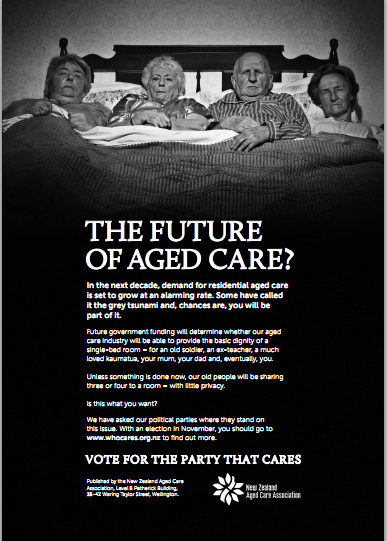Campaign launched to highlight looming crisis in residential care for the aged
Tuesday 27 September 2011, 5:20PM
By Network PR
409 views
The New Zealand Aged Care Association (NZACA) is taking the matter of availability of residential care for the aged to the voters in the November election.
“Demand for aged care will begin to increase sharply within a year or two and climb steadily for a generation as baby boomers move into the elderly age group, and there will simply not be sufficient residential care for them unless something changes”, says NZACA CEO, Martin Taylor.
Rest homes, dementia and hospital care services are supplied by the private sector and are funded largely by payments from Government.
“The current level of government funding is now insufficient to encourage the building of new facilities to meet the demand and this situation will only worsen,” he says. “The Government subsidy would need to increase by 47 per cent for rest homes, 17 per cent for hospitals and 26 per cent for dementia care to support the required $3 billion of investment to build new facilities in the coming decade.”
“If this investment doesn’t happen, then the industry is going to have to cut its costs and a very likely result will be a move to multi-bed rooms with two, three or even four people to a room.
“That would be a huge shock for the elderly who have been used to living independently in their own homes. A few might not mind it but I am picking most will experience a loss of identity and meaning,” he says.
The NZACA has put the case for more funding repeatedly to all the political parties and now has determined to put the alternatives starkly in front of voters to encourage them to tell politicians how they feel about the choices confronting them. The centerpiece of the campaign, which begins this week, will be billboards, newspaper and radio advertising and a website depicting this multi-bed scenario of the future.
“We have decided the campaign needs to be stark and dramatic. It’s too easy to sweep care of the aged under the carpet because for so many of us it is still well in the future. Actually it’s not, it’s about our parents and their friends, old teachers or serviceman who have given to the country and community, and ultimately, of course, it’s about every one of us, Mr Taylor says.
“We know now, in 2011, that we will need more beds in about five years. As we advance through that period beds will become more difficult to find. Providers will be forced to build multi-bed rooms to fit within the funds available and that’s when people will ask how did we let that happen?” says Mr Taylor.
He says the reality is that this situation is facing Canterbury right now as a result of the earthquake. “They don’t have enough beds for their elderly and consequently some elderly residents have been re-located to rest homes in other parts of the country.
“These people are waiting to come home and yet no one is building more beds in Christchurch, but some local facilities have addressed the issue by creating multi-bed rooms. However, the elderly don’t want that.”
All the facts and figures on which these forecasts of demand and supply are based arise from the Aged Residential Care Review 2010. This report was co-authored by the industry and District Health Boards. It was accepted and paid for by the Government.
“We all agree on the problem, but not the solution, Mr Taylor says.
“This issue needs leadership, not denial. We know it’s difficult, but unless government and consumers accept something has to change with funding aged care, and the split between private and public contributions, the issue will move from a looming problem to a present crisis.”
There are limited options for finding the additional funding needed to resolve this issue. One is to just increase taxes on generation x and y to pay for baby boomers.
Another is to take a close look at who pays for what and adjust the asset testing regime and levels of private contribution.
“Asset testing is one of politics’ ‘holy cows’, i.e., don’t go there or you will upset the grey vote.
“The stark nature of the alternatives needs to be portrayed. What will it be? No asset testing and a high asset threshold and four beds to a room in care, or asset testing and a lower asset threshold, but the privacy and dignity of not having to live your last days in a dormitory. It doesn’t get starker,” adds Mr Taylor.
A copy of the full Aged Residential Care Review can be found at:
http://www.grantthornton.co.nz/Assets/documents/home/Aged-Residential-Care-Service-Review.pdf
